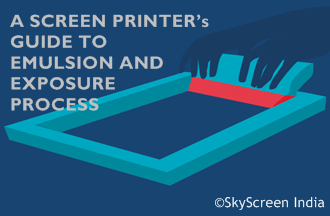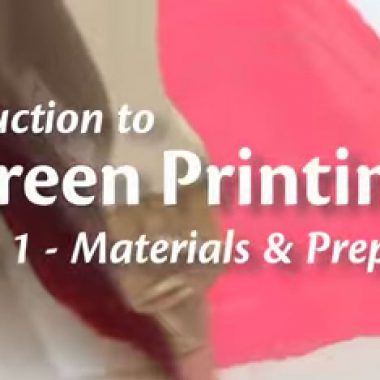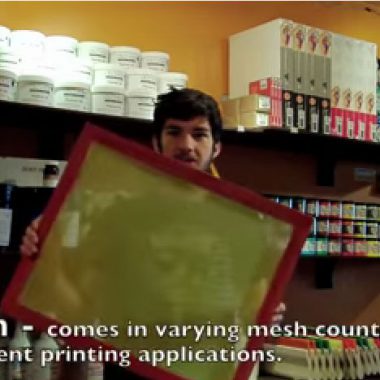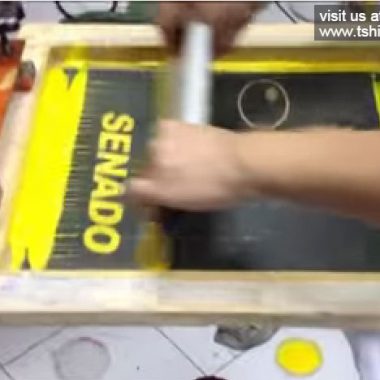THIS IS A SCREEN PRINTING GUIDE that provides step-by-step account of emulsion and exposure process which is important for every screen printer. It is important to observe instructions for the best results in screen printing.
Step 1: PREPARE THE MESH
Begin the mesh preparation by using Microgrit No. 2 before degreasing the screen. Better still, use Ulanogel 23 which combines abrasive and degreasing action and saves you time.. A used mesh or surface treated mesh may be degreased using Ulano’s Screen Degreaser Liquid No. 3 or dilute Screen Degreaser Concentrate No. 33.
For a new mesh mechanical abrasion is advised as it increases the surface area of for a better mechanical bond of the stencil, and increasing printing run life cycle.
Step 2: SENSITIZE THE EMULSION
Usually, screen printing emulsion is too thick. Add lukewarm water to the diazo sensitizer by filling the bottle up to the shoulder. Shake it well. Wait for 15 minutes till the bubbles disperse.
Next, pour the fully dissolved sensitizer into the emulsion. Stir the mix with a clean, flat plastic tool until it is uniform in color. Close the container. Wait at least one hour for the bubbles in screen printing emulsion to disappear. For the record, write the date of sensitizing on the label of the emulsion container.
Step 3: COAT THE SCREEN
“How to coat a screen with emulsion without wasting?” a common conundrum faced by most screen printers. Emulsifying the screen is pretty easy if protocol is followed. You can choose from the below mentioned methods and you will never fail while coating emulsion on your screen:
Method 1: Apply one coat of emulsion on the printing side, then one coat on the squeegee side. Dry the screen thoroughly.
Method 2: Apply two coats on the printing side, then two coats on the squeegee side, without letting the other side to dry. After each coating, rotate the screen 180°. Dry the screen thoroughly in a stencil drying machine with print side facing downwards.
Method 3: Follow Method 2 (above). Then, after drying the screen, apply two additional coats on the printing side, back to back. Dry the screen again.
Step 4: DRY THE SCREEN
Let the multi-coated screens dry in a horizontal position with print side down at room temperature in a dust-free environment. Use a fan to speed up drying process. Avoid high humidity. Under humid conditions, dry the coated screen with warm, filtered air, up to 104° F (40° C) in a stencil dryer. Use a dehumidifier in the drying area, if possible.
Step 5: EXPOSE THE EMULSION
Select an exposure time from the Screen Printing Emulsion Exposure Table based on the type of light source you have and the coating method you use. Multiply the selected exposure time by all relevant exposure variables and distance factors to obtain an Approximate Exposure Time.
Take a Step Wedge Test to determine the optimum exposure. Optimum exposure is indicated when:
■ No outline of the positive or darkening of the emulsion color is observable if the exposure is increased.
■ The squeegee side emulsion is hard and not slimy.
■ A print made from the stencil best duplicates test positive at the required level of resolution.
Step 6: WASH OUT THE EMULSION
One of the most common screen printing problems is emulsion not washing out properly. In order to remove emulsion one must wet both sides of the screen with a gentle spray of cold water. Then using a water power spray, wash out the printing side till the screen is clear.
Rinse both sides with a gentle spray until no soft emulsion is left on the squeegee side, and no foam or bubbles remain. Blot excess water from the printing side with unprinted newspaper stock.
Step 7: BLOCKOUT & TOUCHUP
Blockout Option 1: Before drying and exposure, use excess emulsion from the coating step to cover the blockout area.
Blockout Option 2: After exposure and washout, dry the screen. Apply Screen Filler No. 60 or Extra Heavy Blockout No. 10.
Touchup Option 1: Use excess emulsion and re-expose the screen.
Touchup Option 2: Use Screen Filler No. 60 or Extra Heavy Blockout No. 10 thinned with water. Dry the screen.
Step 8: RECLAIM THE SCREEN
Remove the ink with the solvent recommended by the ink manufacturer. Rinse with water. Degrease with Screen Degreaser Liquid No. 3 to remove oily ink and solvent residues. Rinse the screen. Brush Stencil Remover Liquid No. 4 or Stencil Remover Paste No. 5 on both sides of the screen.
Do not let the stencil remover dry on the screen. Rinse gently, then use a forceful spray of water. Use Haze Remover Paste No. 78 to remove ink and haze and stencil scum residues, if necessary.
With this handy screen printing guide, you too can get started on using your emulsions. It is recommended that you observe proper safety guidelines while using screen printing chemicals, and emulsions.






